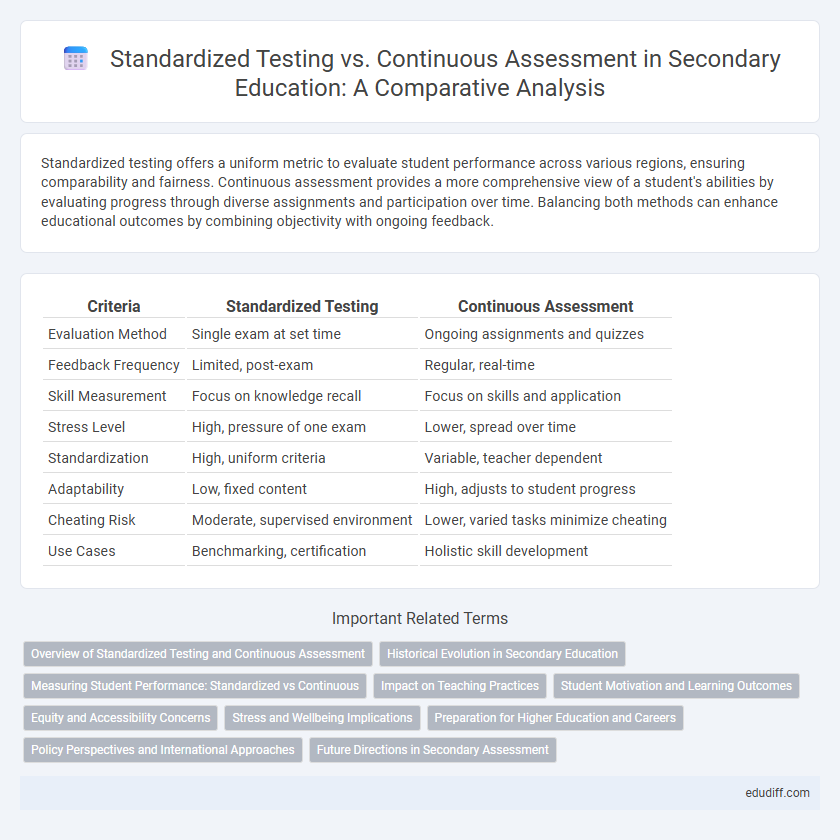Standardized testing offers a uniform metric to evaluate student performance across various regions, ensuring comparability and fairness. Continuous assessment provides a more comprehensive view of a student's abilities by evaluating progress through diverse assignments and participation over time. Balancing both methods can enhance educational outcomes by combining objectivity with ongoing feedback.
Table of Comparison
| Criteria | Standardized Testing | Continuous Assessment |
|---|---|---|
| Evaluation Method | Single exam at set time | Ongoing assignments and quizzes |
| Feedback Frequency | Limited, post-exam | Regular, real-time |
| Skill Measurement | Focus on knowledge recall | Focus on skills and application |
| Stress Level | High, pressure of one exam | Lower, spread over time |
| Standardization | High, uniform criteria | Variable, teacher dependent |
| Adaptability | Low, fixed content | High, adjusts to student progress |
| Cheating Risk | Moderate, supervised environment | Lower, varied tasks minimize cheating |
| Use Cases | Benchmarking, certification | Holistic skill development |
Overview of Standardized Testing and Continuous Assessment
Standardized testing involves uniform exams administered to all students under consistent conditions, providing measurable data on academic performance and comparison across schools or regions. Continuous assessment consists of various evaluation methods such as quizzes, assignments, and projects conducted throughout the academic term to monitor ongoing student progress. Both approaches offer distinct insights into learning outcomes, with standardized tests emphasizing summative evaluation and continuous assessments supporting formative feedback.
Historical Evolution in Secondary Education
Standardized testing in secondary education emerged in the early 20th century as a tool for objectively measuring student achievement across diverse populations. Continuous assessment evolved later, gaining prominence in the late 20th century as educators sought more comprehensive evaluations reflecting student progress over time. The historical shift highlights a move from rigid, one-time exams towards diverse, formative assessment practices in secondary schools.
Measuring Student Performance: Standardized vs Continuous
Standardized testing provides a uniform metric for measuring student performance, enabling comparisons across different schools and districts through objective scoring criteria. Continuous assessment offers a dynamic evaluation by tracking student progress over time using diverse methods such as quizzes, projects, and class participation. Combining both approaches can yield comprehensive insights into academic achievement and areas needing improvement.
Impact on Teaching Practices
Standardized testing shapes teaching practices by emphasizing test preparation, often narrowing curriculum focus to tested subjects and skills. Continuous assessment encourages ongoing feedback and adaptive instruction, promoting diverse teaching methods and deeper student understanding. Educators using continuous assessment integrate formative evaluations to tailor lessons and support individual learning progression.
Student Motivation and Learning Outcomes
Standardized testing often increases student anxiety and narrows learning to test-focused content, which can diminish intrinsic motivation and limit deeper understanding. Continuous assessment, by providing regular feedback and diverse evaluation methods, fosters sustained engagement and promotes a more comprehensive grasp of material. Research shows continuous assessment correlates with higher long-term retention and improved student motivation compared to high-stakes standardized exams.
Equity and Accessibility Concerns
Standardized testing often exacerbates equity issues by privileging students with access to resources like test prep and stable testing environments, while continuous assessment provides a more inclusive measure by accounting for diverse learning styles and ongoing performance. Equity concerns arise from cultural biases and socioeconomic disparities inherent in standardized exams, highlighting the need for flexible assessment methods that accommodate varied student backgrounds. Continuous assessment promotes accessibility by offering multiple opportunities for students to demonstrate understanding, reducing high-stakes pressure and improving fairness across different demographics.
Stress and Wellbeing Implications
Standardized testing often leads to elevated stress levels among secondary students due to high-stakes environments and time constraints, negatively impacting their overall wellbeing. Continuous assessment offers a more balanced approach by allowing regular feedback and reducing exam-related anxiety, promoting mental health and sustained academic engagement. Schools implementing continuous assessment report improved student resilience, lower stress symptoms, and enhanced emotional stability compared to reliance on singular standardized exams.
Preparation for Higher Education and Careers
Standardized testing provides a uniform measure of academic achievement, essential for college admissions and scholarship selections in higher education. Continuous assessment offers a comprehensive evaluation of student skills and competencies over time, aligning better with career readiness and real-world problem-solving. Combining both methods equips students with the necessary academic foundation and practical experience for success in higher education and competitive job markets.
Policy Perspectives and International Approaches
Policy perspectives on standardized testing emphasize uniformity and comparability of student performance across regions, enabling governments to monitor educational outcomes efficiently. International approaches reveal a growing trend toward integrating continuous assessment methods, as seen in Finland and Singapore, where formative evaluations support personalized learning and holistic development. Balancing standardized tests with continuous assessment aligns with global educational reforms aimed at fostering critical thinking and reducing achievement gaps.
Future Directions in Secondary Assessment
Future directions in secondary assessment emphasize integrating standardized testing with continuous assessment methods to foster a holistic evaluation of student learning. Advancements in technology enable adaptive testing and real-time analytics, allowing personalized feedback and improved instructional strategies. Emerging educational frameworks advocate for competency-based assessments that prioritize critical thinking, creativity, and collaboration skills alongside traditional academic metrics.
Standardized Testing vs Continuous Assessment Infographic

 edudiff.com
edudiff.com